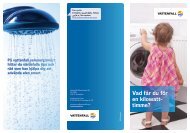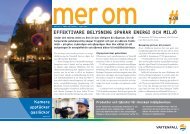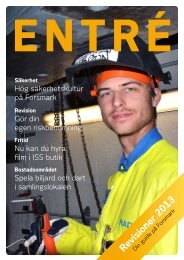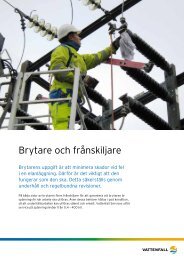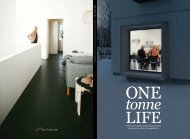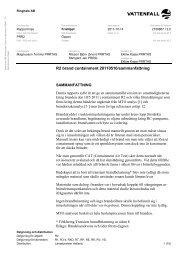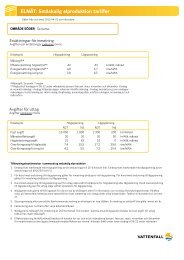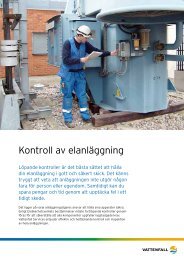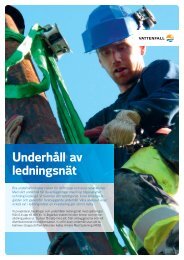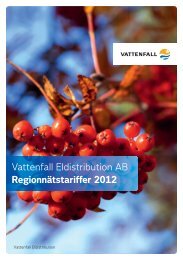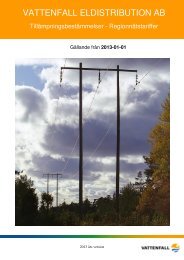This environmental impact assessment for Kriegers flak ... - Vattenfall
This environmental impact assessment for Kriegers flak ... - Vattenfall
This environmental impact assessment for Kriegers flak ... - Vattenfall
Create successful ePaper yourself
Turn your PDF publications into a flip-book with our unique Google optimized e-Paper software.
12.4 Fauna<br />
The occurrence of invertebrate benthic fauna is described<br />
in Chapter 11.6.1.<br />
12.4.1 Invertebrate benthic fauna<br />
12.4.1.1 Impact<br />
The wind farm may cause negative <strong>impact</strong> on the<br />
benthic fauna as part of the seabed is occupied by the<br />
turbines, due to changed sedimentation and due to<br />
spills and pollution.<br />
a) Occupied seabed/secondary hard structure<br />
The foundations of the turbines occupy about 0,008 %<br />
of the total area of the wind farm and this space will<br />
disappear <strong>for</strong> the benthic fauna. In addition, the area<br />
occupied by the trans<strong>for</strong>mer stations and the temporary<br />
disturbance when laying the cables in the wind farm<br />
area is also taken, but the occupied area is a negligible<br />
part of the total area. The direct loss of seabed due<br />
to permanent installations will, with high probability<br />
there<strong>for</strong>e, not be of importance <strong>for</strong> the macrozoobentos<br />
present in the area.<br />
Each foundation will also <strong>for</strong>m a secondary, new<br />
hard structure with an area of between 400 and 900<br />
m2, which is ten to twenty times larger than the lost<br />
hard seabed, albeit with a different spread of depth.<br />
The secondary hard surfaces will probably compensate<br />
<strong>for</strong> the loss of hard seabed.<br />
b) Clouding and changed sedimentation<br />
Due to work with the foundations, clouding and<br />
temporary increased sedimentation may occur during<br />
the construction and dismantling phases, and due to<br />
changed ß owing conditions the same may occur during<br />
the operational phase. The worst problems are estimated<br />
to occur during the construction and dismantling<br />
phases.<br />
The marine seabed fauna can, within a limited area,<br />
be subjected to increased sedimentation through over<br />
layering of sediments. <strong>This</strong> could result in reduced<br />
growth, reduced survival or direct death. Certain<br />
species can penetrate up to 90 cm thick layers of sand<br />
whilst other species cannot even survive an over layering<br />
of a few centimetres.<br />
CONSEQUENSES OF THE WIND FARM 123<br />
Indirect consequences may also occur due to reduced<br />
occurrence of food due to reduced survival of<br />
marine algae.<br />
Adhesive fauna are dependent on water transport <strong>for</strong><br />
nourishment and <strong>for</strong> these animals, an increase of sediment<br />
in the water may have a negative <strong>impact</strong> as in and<br />
outß ow openings may become blocked.<br />
Mobile fauna may also be subjected to clouding.<br />
Stationary or semi stationary species (<strong>for</strong> example sedentary<br />
polycheats) are more sensitive than those that<br />
can move (nekton, <strong>for</strong> example crayÞ sh).<br />
During the operational phase, changed water ß owing<br />
patterns in the areas immediately behind the wind<br />
turbines, may lead to locally changed sedimentation<br />
conditions, which possibly may lead to changes in the<br />
local habitat.<br />
c) Spills and pollution<br />
Minor leakages should not cause any important negative<br />
<strong>impact</strong> on benthic fauna, but large volumes of oil<br />
or other hazardous substances could cause great damage.<br />
The risk of spills and leakage is considered as very<br />
low (see Chapter 5.7.2.3). Also, the risk of collisions<br />
causing oil spill has been deemed as very low (see<br />
Chapter 12.8.2).<br />
Summary of <strong>impact</strong> on benthic fauna.<br />
In summary it may be noted that sediment and sedimentation<br />
may cause negative <strong>impact</strong> <strong>for</strong> benthic fauna<br />
in the immediate vicinity when the foundations are<br />
laid/dismantled. <strong>This</strong> <strong>impact</strong> is limited in time. Larger<br />
spills and pollution would cause great damage but the<br />
risk thereof is considered small.<br />
12.4.1.2 Mitigating measures<br />
Areas with a high concentration of macrozoobentos<br />
should, if possible, be avoided.<br />
By using a hose to suck-up free sediments during the<br />
construction phase, sediment spreading will be minimised.<br />
Special containers will be present on the wind<br />
turbines to prevent oil spills (see 5.7.2.3) and the collision<br />
avoiding measures recommended by SSPA will be<br />
proposed by Sweden Offshore. Decision in this matter<br />
will be made in consultation with affected authorities.




